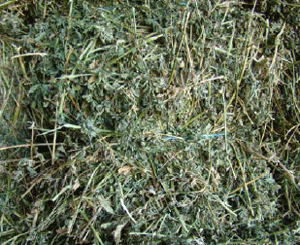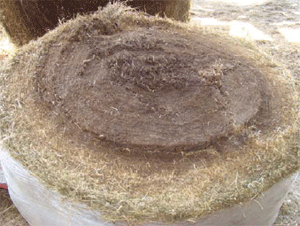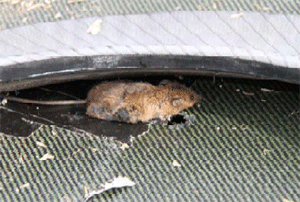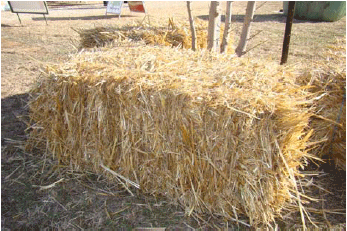



Buying Hay or Silage after a Flood, Fire or Drought
Home grown or purchased hay or silage are extremely valuable feeds after a flood or fire. If well made, they should be safe to feed and are excellent “comfort food” for short term feeding of cattle, horses, sheep and other grazing animals, writes Neil Griffiths Technical Specialist Pastures Paterson with New South Wales, Australian government.Use of hay or silage for longer term feeding after a flood, fire or during drought depends on feed quality and cost relative to other feeding alternatives.
Silage has many advantages when made and used on farm, however high moisture content and perishability compared to hay are disadvantages when purchasing and transporting silage.
Silage is preserved by fermentation and normally is 40 to 60% dry matter (or 60 to 40% moisture). By comparison, hay is usually 85 to 90% dry matter. This must be taken into account when comparing the purchase price (see section ‘Dry matter is important’) and transport costs for silage against hay.
Silage must be sealed, and remain sealed, to exclude air. Maintaining an airtight seal during transport is difficult. Once the seal is broken, eg. a hole in the plastic or the silage is opened then the silage will start to heat and spoil.
Rate of spoilage will vary depending on the type of silage and weather conditions. Spoilage will be fastest during warm conditions with high quality silage such as maize or ryegrass. Cool conditions may slow down the spoilage process. Silage made from legumes or summer grasses tends to spoil more slowly.
Spoiled silage has lower feed value, may be unpalatable and can be an animal health risk, with moulds and botulism the major concerns.
Hay is usually a more efficient purchased feed, provided it is of suitable quality.
Straw, stubble and low quality hay are often made available in an emergency. While these products have a useful comfort factor and may be used in a mixed ration they are not suitable for long term feeding, often have high wastage and can be expensive per unit of energy if transported a significant distance.
Feed quality
Making hay and silage never improves feed quality – the challenge is to retain as much of the feed value of the standing crop or pasture as possible.
Feed quality is best measured in a laboratory but there are a number of other indicators which can be used if test results are not available.
Plant type and growth stage
Plant type and growth stage are the major factors affecting feed quality.
Temperate grasses and legumes have higher potential feed quality than tropical summer growing grasses.
Green, leafy plants have higher feed quality than mature plants with coarse stems and seed heads.
With these two principles in mind, other factors can also influence the feed value of hay or silage.
Some crops and pastures such as ryegrass and maize are easy to make into silage while legumes and summer grasses including forage sorghum require ideal drying conditions to get a good result.
Cereals with grain in the seed head can make good pit silage but can attract mice if made into hay.
Leafiness

Leafiness, combined with plant type and growth stage are indicators of feed quality and drying conditions.
Loss of leaf can occur if hay is slow to dry or if it is damaged by raking and baling when it is too dry. Lucerne is particularly at risk of leaf loss during raking and baling.
Potentially good hay will lose feed value if leaf is lost.
Leaf loss is not usually a problem with silage because it is made at higher moisture levels.
Colour, weather damage and heating
Colour is an indicator of drying conditions and feed quality. A bright green colour indicates that the hay was preserved quickly retaining as much feed value as possible.
Light brown or bleached hay indicates the forage was exposed to sun and may have lost feed quality unless it dried quickly.
Dark brown hay or silage indicates that the hay or silage has heated excessively and will have lost feed value. This hay or silage may be very palatable but of low feed value.

Smell
Smell is also an indicator of well preserved hay or silage. Good hay will have a fresh, sweet ‘hay’ smell. Good silage has a sweet, acid smell.
Dust and mould are the major smells which indicate lower quality hay or silage. Other odours can indicate weed problems, the presence of rodents or a burnt caramel smell can indicate overheating.
Odour can also be an indicator of poor fermentation of silage. Poorly fermented silage may have a sour, vinegar smell or bad silage may smell rancid or putrid. Heat damaged hay or silage may have a sweet caramelised odour and is palatable but of low nutritive value.
While odour is a useful indicator of hay and silage quality, care must be taken as smelling can also involve human health risk, e.g. moulds.
Weeds, mould and foreign matter
Weeds, mould and foreign matter are indicators of reduced feed value and possible animal health risk.
Moulds indicate that hay and silage have lost feed value and may be dangerous. Hay will go mouldy if it is wet when made or during storage. Silage will go mouldy if exposed to air.
Mouldy hay and silage can also cause respiratory or other health concerns to both people and animals. To minimise risk people should avoid direct contact with moulds and avoid breathing the fungal spores.
If animals must be offered mouldy hay or silage they should have easy access to sufficient hay or silage so they can avoid eating undesirable mouldy portions.
Special care should be taken when feeding mouldy or high risk hay or silage to sheep or pregnant animals which tend to be more susceptible to health problems, particularly listeriosis.
Weeds often have low feed value, may taint milk or meat and can be poisonous, so it is important to know which weeds or weed seeds may be in hay or silage.
Hay is notorious for spreading weed seeds and where possible, should be fed to stock in a confined area which can be checked in future to guard against introduction of new, unwanted problems.
Silage fermentation can reduce the risk of spreading viable weed seed. This cannot however be guaranteed, so similar precautions should be taken when feeding introduced baled silage.
Foreign material such as sticks, wire and twine are sometimes found in bales of hay or silage. Usually this contamination is a nuisance and reduces the value of the hay or silage. In some situations it may damage equipment or be eaten, causing animal health problems or “hardware disease”.
Mice and rats
Rats and mice may infest hay or silage after a flood or may be introduced in purchased fodder. Their presence will give the hay and silage an offensive odour, affecting palatability.
Mice can also transmit diseases such as salmonella, leptospirosis, internal parasites and fungal diseases to humans and animals.

Dead mice or rats amongst hay or silage will increase the risk of botulism in animals. Consider vaccinating stock at risk.
If mice or rats are a problem then normal baiting procedures should be followed and care taken to remove dead rodents before offering hay or silage to animals.
Using bales that have been in water
Hay and silage bales may be moved by flood water. If they can be salvaged after a short period in water they can be fed to animals. However, water damage will cause the hay to heat, spoil and go mouldy, so they should be used quickly.
Silage bales will float and remain in good condition if the plastic wrap remains sealed. Bales floating high in the water indicates that they have not absorbed much water. Bales at or below the water surface will have absorbed water and are likely to spoil quickly.

Dry matter is important
It is important to know the dry matter content (percentage) of hay or silage when calculating how much to feed and when comparing price and relative cost of different feeds.
If buying hay or silage you need to know price per tonne or price per bale, number of bales per tonne and have an estimate of dry matter or moisture percentage.
Example
Hay costs $80/bale, weighs 400 kg per bale and is 15% moisture (85% dry matter).
| 400 kg x 85% DM | = 340 kg DM/bale |
| 1,000 ÷ 340 | = 2.94 bales per t DM |
| 2.94 x $80 | = $235.29 /t DM |
This method can be used to compare the cost of hay and silage.
The comparison is improved if feed quality is known and cost in ¢/MJ ME is calculated.




February 2012


